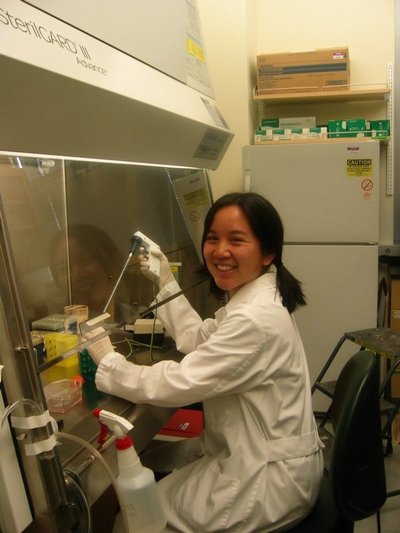May 9, 2007
UW undergraduates to present research at symposium May 18
Katharine Liang, a UW senior, initially got interested in medical research to help her mom, who because of myopic degeneration and glaucoma is legally blind. Now a neurobiology major, Liang studies biomaterials, as they are providing solutions such as artificial lenses and retinal implants.
The work fascinates her.
Liang is one of the undergraduates who will present their work at the 10th annual Undergraduate Research Symposium from noon to 5 p.m. Friday, May 18, in Mary Gates Hall. Projects range from neurobiology studies such as Liang’s to dance influenced by digital design.
“The Symposium is one way to show the explosion in undergraduate involvement in research with faculty,” said Janice DeCosmo, associate dean of Undergraduate Academic Affairs and director of the Undergraduate Research Program. “At the first symposium, 70 students presented their research. This year more than 625 will.”
Students say hands-on research exposes them to field work with faculty, peer learning and career choices, and that it also provides extra edge in graduate school applications.
UW students like Liang will be joined by others from Seattle University, the University of Puget Sound, Evergreen State College, North Seattle Community College and Seattle Pacific University to share results from mentor-supervised research.
Here are some of the UW presenters:
- Senior Dan Blizzard of Spokane Valley, Wash., and sophomore Pavan Vaswani of Vancouver, Wash., use ultrasound to measure brain pressure, a critical indicator of brain function after trauma or other serious event. Untreated swelling can lead to permanent damage or death. Intracranial pressure is usually measured by routing a transducer through a hole in the skull, whereas ultrasound is non-invasive.
- Senior Luke Kearney of University Place and junior Daniel Hemmons of Burien are working on a robot that detects wear in power cables. According to information from the pair, current methods of detecting wear are often expensive or inefficient. Future models of the robot will be customized for individual utilities.
- Senior Shannon Narasimhan of Boise, Idaho, along with a small UW group, created a performance that merges dance with digital art design.
- Senior Leah Schrager of Olympia, like Narasimhan, is majoring in dance and biology. She investigated how dancers’ unique perspectives on the human body affect their lives. They often, for example, find liberation in heightened awareness of the body but constraint in weight control.
- Seattle sophomore Deva Wells will show what’s happened to popular Cuban music since the fall of the Soviet Union and rise of globalization. Visiting cities such as Havana and Cienfuegos showed Wells that such music is generating commercial interest and capturing aspirations of Cuban young people. “I was stunned at how expressive a medium popular Cuban music could be; it clearly took on a new role of social commentary, and stretched the limits of permissible speech in Cuba — a kind of festive sermon that could truly move the masses.”
- Senior Shannon Schmoll of Fircrest and her mentor in astronomy, Ana Larson, created two tutorials and an exercise that help introductory astronomy students understand how, because of the earth’s orbit, stars seem to shift in the sky. Students were required to solve problems using actual astronomical data.
- Senior Alex Zheng of Sammamish and his research partners are studying what happens to chronic disease patterns when the diet of a large population changes. What’s happening in Asia, for example, as significantly more protein (meat, fish, chicken) is added to a diet where small amounts of protein had been the norm? To what extent are these changes linked to chronic disease patterns, and which of these changes interest nutritionists and epidemiologists? Zheng is keen to help society, but there’s also the sheer thrill of the research: “It’s kind of neat discovering things on your own.”
###
For more information, contact Janice DeCosmo, assistant dean of undergraduate education at (206) 221-6178 or jdecosmo@u.washington.edu or Jennifer Harris, associate director, Undergraduate Research Program at (206) 616-3586 or genoveva@u.washington.edu . Mary Gates Hall (Seattle UW campus) map at: http://www.washington.edu/home/maps/?MGH

